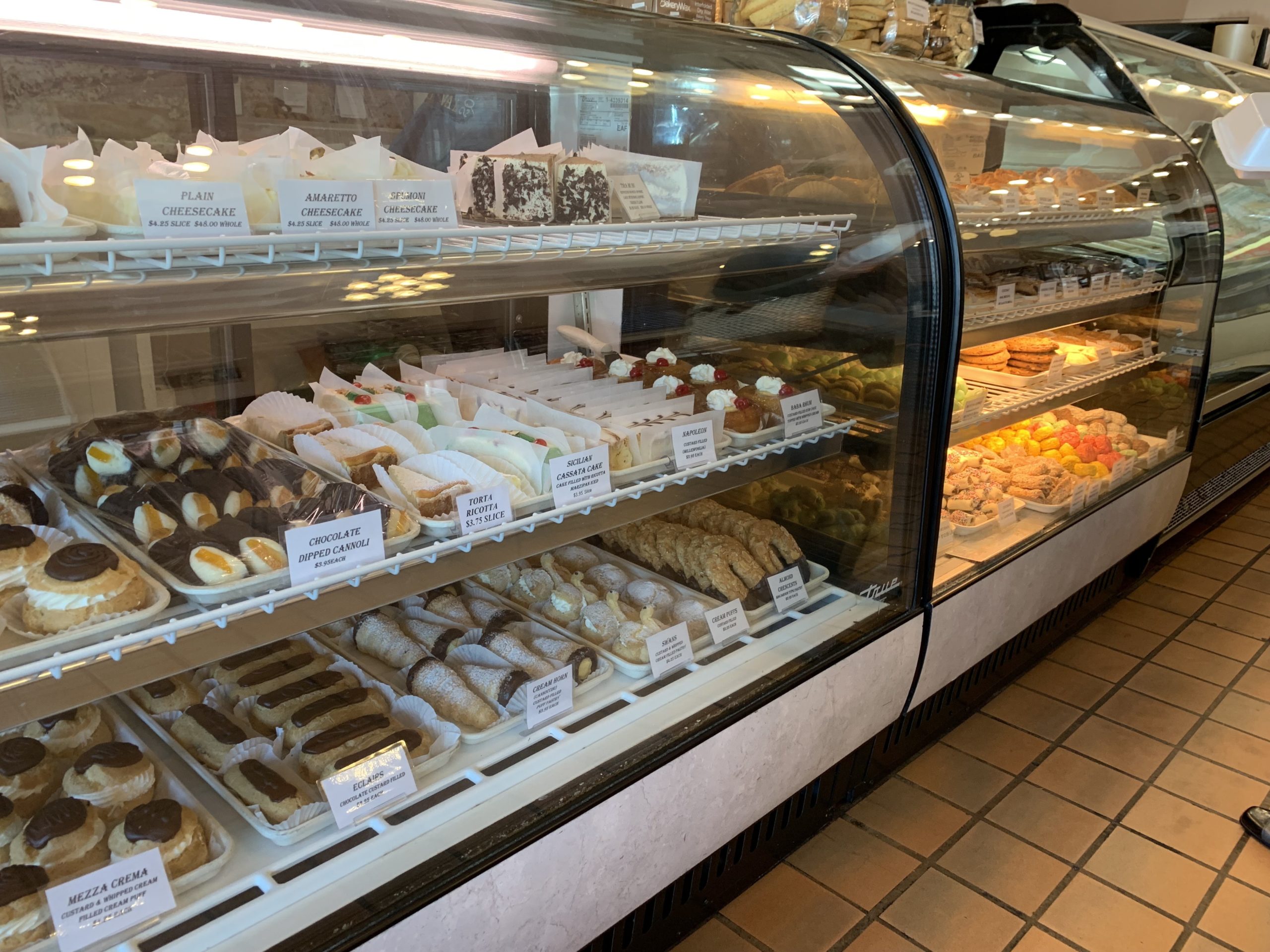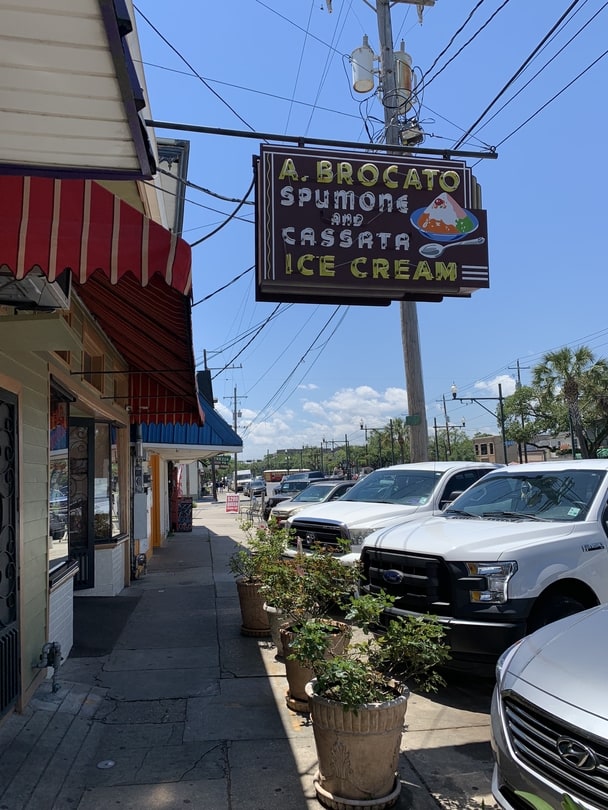“On warm summer nights, the violins would play as horse-drawn carriages pulled up to the fashionable ice cream parlors on Palermo’s waterfront. Elegant ladies and gentlemen, many from Sicily’s royal family, would step out and sit down to their favorite dessert of lemon ice, spumoni or cassata. Inside the kitchens, young boys – among them, Angelo Brocato – scurried about, ferrying ice and salt for the busy chefs.”
This is the opening paragraph of a 1975 article from the Times-Picayune.
The story of New Orleans’ most famous ice cream shop began approximately 125 years ago. It began across an ocean in Palermo, Sicily, when 12-year old Angelo — whose father passed away when he was 3 years old — began his apprenticeship in the gelato trade to earn money for his family. He learned the gelato business, and as summer became winter and shops changed their focus, Angelo mastered candy-making and baking, as well.
But he wouldn’t stay in Sicily much longer.
Starting in 1884 and continuing through to 1924, an estimated 290,000 Italian immigrants – a great deal of them from Sicily– arrived in New Orleans, fleeing economic and political turmoil. As many wealthy French Quarter residents fled to the suburban feel of Uptown, the new Sicilians took their place, forming what was referred to as “Little Palermo.”
In approximately 1898, at the age of 20, Angelo joined that number. He began by working on a sugar plantation in Donaldsonville, LA until he had saved enough money to bring his wife and son over from Italy. The following year, once his family arrived, they moved to Little Palermo and Angelo opened up a tiny ice cream shop in a converted garage at 511 Ursulines Avenue.
Sadly, three months after their second child was born, his wife died of yellow fever as so many New Orleanians did. Angelo grieved, but eventually remarried and fathered five more children.
He moved the shop up a block to 623 Ursulines and stayed there until about 1916. Operations moved down to 518 Ursulines, but then — in 1921 — Angelo proudly converted a dry goods store into what he called his “big shop.” The new store, at 615-617 Ursulines Avenue, was large enough for his growing business to operate downstairs, while his growing family took over the second floor.
While the shop has since moved to Mid-City, much of the founder’s vision for his store can still be seen, more than 115 years later, in that old location: the tiled floors reminiscent of Palermo, the archways common in Italian ice cream shops of old, and – perhaps most famously – the division of the shop into a men’s salon and a women’s salon (to protect single ladies from the incessant advances of admiring men, of course).
In a 1975 interview, Angelo Brocato, Jr., who began working for his dad — Angelo, Sr. — when he was a little kid, told the Times-Picayune about their then-current shop on Ursulines, “It’s all the same – the ceiling fans, even the white glass-top tables and the soda fountain chairs. 70 years my father’d been having ‘em… the only thing missing is the sawdust on the floor – the health board won’t allow it, but it sure was good for absorbing water, moisture from the ice.”
Looking for the Past
Earlier this week, as the late-morning sun baked down on New Orleans, I biked up to Ursulines Avenue to see what I could find. And, what I found was a bustling street: two- and three-story buildings with yellow, brown, red, beige or green fronts and exposed brick sides; ornate balconies overlooking a street teeming with wandering tourists, service workers on lunch, and groups on French Quarter tours. It was the kind of weather and foot traffic that could sustain an ice cream shop.
I imagined what it was like around here during the decades of Little Palermo. From 1905 to World War II, this section (from Dumaine to Esplanade, Rampart to the French Market) was nearly all Italian. In that same Times-Picayune interview, Angelo, Jr. – who took over the business with his brother when his Dad died in 1946 — spoke about lines out the door every night. “We had four car hops [waiters who would deliver to your car] then, and you could park on both sides of the street – you weren’t afraid of towing in those days!
“There used to be seven ice cream businesses” in the area, he said. “They all closed up except us.”
What made Angelo Brocato’s so different?
“We use all my father’s recipes from Sicily, and the people know it.”
When I biked up to 615-617 Ursulines Street, evidence of Angelo’s “big shop” was everywhere. I could see the upstairs rooms where the Brocatos used to live. I saw the two separate tiled entrances — one for males and one for females — with “Angelo Brocato” spelled in tiny green slates. I tried to take a picture of the “Ladies Entrance,” marker that still exists, but a homeless woman had set up shop in the doorway because the modern-day tenants, Le Croissant d’Or, were closed for the day.
I peeked in the window and saw the archway between rooms, as well as the white tile floors I imagined had been there for a century, where Angelo, Jr. said – during hot, New Orleans summer mornings like this one — Italians in the neighborhood would stop by “with empty pitchers; they’d fill ‘em up with lemon ice, go home and eat it with hot Italian bread for breakfast.”
After World War II, the neighborhood began to change in a big way. The French Quarter was getting more expensive, and Italian-Americans were dispersing throughout the city. But loyal customers continued to travel into the Quarter from their new homes across the metropolitan area to purchase quarts of Brocato’s gelato. To adapt to this new geography, Angelo Jr. and his brother began distributing to larger grocers around New Orleans in order to sell directly to customers closer to where they lived.
Because of these trends, in the late 1970s, Angelo, Jr. opened a second shop on North Carrollton Avenue (the site of their current shop). The Ursulines Avenue location closed its doors in 1981 (though they kept a presence near Jackson Square for a time), and Angelo, Jr. died the following year, passing the store to his sons Arthur and Angelo III, as well as to the other siblings who had, like their father and grandfather before them, been working in the business since they were children.
“It’ll never be like the French Quarter,” Angelo, Jr. said about the new shop in an interview the year he passed away.
But maybe he would have learned to love the new store just as much if he had more time with it. Later that day, I’d remember just how much I love it.
Ice Cream of the Present
After an afternoon of researching gelato, it was time to actually eat some.
The store is near the corner of Carrollton and Bienville, which I’ve always thought was a charming node of New Orleans. Mexican restaurants, Italian restaurants, and Chinese restaurants; cocktail bars and dive bars — all packed into two tiny blocks. And, in the middle of it all, is Angelo Brocato’s, which – with its red awning, illuminated sign, and large windows revealing several customers chatting around small tables placed under slowly rotating fans – still has an Old World charm to it.
View this post on Instagram
It is a lazy Wednesday night when I walk in. Three young women laugh behind the counter. One breaks away to ask me if I know what I’d like, but — as I stare at nearly 20 flavors of housemade gelato — I’m suffering from decision paralysis.
So I pull an ice cream move I’ve perfected over the years. Pointing to each flavor as I narrate, I ask, “Can I try the panna cotta, the king cake, and the creole cream cheese?” with no intention of actually ordering any of them. You might think that’s a jerk thing to do, but if I’ve just tried them for free, why would I waste my order on it? To me, samples seem like the perfect opportunity to try the things of which I’m not going to get a full serving.
She hands me three small spoons, and I try each. The chunks of Caluda’s king cake is a delicious touch, but I’m a panna cotta man all the way. I almost break all the rules and… order it. But, not so fast.
I can’t decide. So many flavors. And that doesn’t even take into account the full bakery’s worth of options. And those miscellaneous items on the side. “Ooooohhhhhh,” I let out the kind of moan an animal makes just before it dies. “I’m not sure. What’s the best thing?”
“The best… thing?” she looked at me for guidance. “In the whole store?”
I nod.
She dutifully lists off items and, she and I are both overwhelmed by how annoying I am. But then she tells me torroncino was the shop’s original flavor more than a century ago.
I’m not usually a traditionalist, but if I’m researching the history of Angelo Brocato’s, it only makes sense to go to the beginning with our protagonist’s original creation. Torroncino, it is.
It’s made the way all gelato flavors were back then: the gelato was poured into loaf-shaped molds and sliced for serving. She slides the slab of rectangular ice cream onto a dolly resting on a plate, the same recipe presented in the same way for more than 100 years. (The only difference is the molds are now stainless steel instead of tin.)
View this post on Instagram
Cool, creamy and flavored with almonds and cinnamon, it was both historic AND delicious.
A Family Looks to the Future
A quiet, delicious Wednesday night inside Angelo Brocato’s. I watched the employees do their work, and think of all the employees I can’t see — making the gelato and baking the pastries.
I imagined what it would have been like to be Angelo, Sr. doing this all summer as a 12-year-old in Palermo. Or for young Angelo, Jr. or his son, Arthur, heading into the shop after school or on the weekends. It’s been a family affair for a long time. In 2005, during an interview for the shop’s 100th anniversary, Arthur talked about how his 84-year-old uncle would still come into the shop to fill cannoli.
He talked about how they have had cookie molds passed through three generations of Brocatos. He told Nola.com how “he and six siblings would groan when they saw a wagonload of cuccuzza, a long gourd-shaped squash, coming their way. They knew they would have to help clean, peel, soak, rinse, soak in sugar syrup and finally pack all that candied cuccuzza into big crocks to store in the back room, a process that took weeks.”
When I first mentioned to some friends I was writing a piece on Angelo Brocato’s, I was amazed at how many held its reopening as such an important moment in the post-Katrina recovery. “I’ll never forget the day it re-opened,” one friend told me about her experience in September 2006, more than a year after the storm. “We had heard rumors they were closing for good, but then when they opened, and they had a band playing for customers, we waited in line for three hours on a Sunday to show our support. It just felt good to see something that was so New Orleans come back.”
And Angelo Brocato’s is so New Orleans. Thousands of pounds of seed cakes and biscotti decorate St. Joseph’s Day altars around the city. Countless New Orleans freezers are filled with their Italian ices. Another friend told me her little sister’s first complete sentence was, “I like this place!”
Arthur Brocato explained to Resilient NOLA that what he enjoyed most “is seeing the young people who come to the store, having an appreciation for what we offer. It signals a future, and a belief that this experience… will continue to new generations. It’s an appreciation for the old things.”
Old things that started with his grandfather in 19th century Palermo and continue on this steamy, New Orleans Wednesday night.








